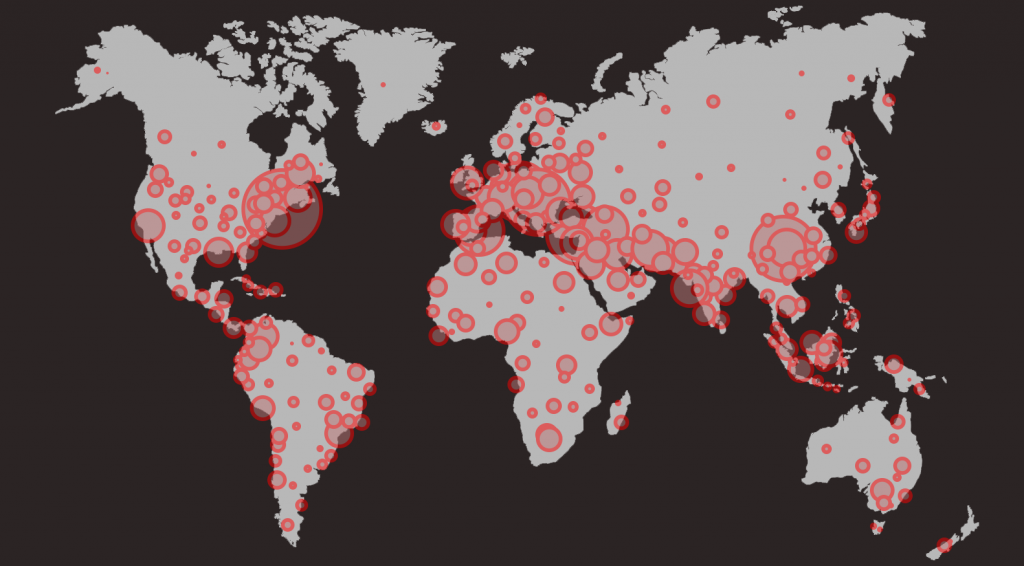
Sage Kiernan-Sherrow | News Editor
The Coronavirus, or COVID-19, as it is more accurately referred to, first began as a series of cases of what was presumed to be pneumonia in Wuhan, China. By Jan. 11, China had reported its first death and it became clear that COVID-19 was neither just pneumonia, nor an ordinary case of the flu. It began to spread outwards from China’s borders; on Jan. 21, the U.S. received its first case when a Washington state resident traveling back from Wuhan tested positive for the virus. He survived, but Washington became an epicenter for the virus; later, it was surpassed by twelve other states, the foremost being New York, which currently has reported over 202,208 cases and 10,834 deaths as of April 14, according to The New York Times. But what is the “Coronavirus” exactly? And why have the measures established to reduce it been so extreme?
The term “Coronavirus” is misleading; Coronaviruses are actually a large group of newly discovered viruses that often affect animals and rarely humans. It’s important to note that while it is suspected that this specific branch of Coronavirus, COVID-19, was contracted through animals, it’s pure speculation that the source of the illness was from bats and snakes in Chinese markets. COVID-19, in short, is a respiratory illness with symptoms that mimic the flu: fever, coughing, shortness of breath and even losing one’s sense of taste. But, according to the CDC, it is significantly more contagious. So contagious, in fact, that the World Health Organization (WHO) officially declared COVID-19 a national pandemic on March 11.
However, there were many events that occurred between the first case and WHO’s official statement. Misinformation and miscalculation combined with a lack of resources and research have contributed to the current situation. In the beginning, even medical professionals were suggesting that COVID-19 was simply ‘not a big deal,’ — presumably because of the limited research on this new strand of viruses. In an interview with govtech.com, Dr. Nancy Messonier, the Director of the National Center for Immunization and Respiratory Diseases at the CDC said, “the virus is not spreading in the community. For that reason, we continue to believe that the immediate health risk from the new virus to the general American public is low.” That was Jan. 28, seven days after the first U.S. case. Since then, the U.S. has become the leading country in COVID-19 cases; China, on the other hand, has significantly reduced its outbreak. So, why is the U.S. behind on controlling its outbreak? This could be attributed to the U.S.’s limited leadership and resources.
Simply put, the United States is behind on testing for COVID-19. Stephan Thomke of the Harvard Business Review suggests that the central reason for this is America’s culture.
“Testing early and often is often viewed as wasteful in the eyes of organizations that emphasize efficiency and predictability,” stated Thomke.
The U.S. is a capitalist country. As such, it prioritizes financial acquisition. In the recent weeks, the Dow Jones plummeted more than 3,000 points after schools and businesses shut down to reduce the spread of the virus, leaving many in financial distress with fears of another recession. In relation to this, President Donald Trump once again changed his standpoint on the measures taken to prevent the spread of COVID-19. In one news conference on March 23, President Trump stated, “America will again, and soon, be open for business … We cannot let the cure be worse than the problem itself,” after having previously denied the virus’ legitimacy, referred to it as the “Chinese Virus” and generally assisted in the spread of misinformation.
At the same time, medical professionals are declaring a severe lack of resources. Hospitals are overpacked, and, while researchers at the Institute for Health Metrics and Evaluation projected that the virus peaked in the U.S. over Easter weekend, medical professionals suggest against reopening the borders or stopping social distancing procedures too early in fears of a spike in infections.
Already, there has been resistance to the established social distancing etiquette, which basically constitutes wearing a mask, staying six feet away from others and practicing basic hygiene. And, after the initial apocalypse-like mass hysteria, where droves of people ransacked stores in order to hoard essentials like toilet paper, a spike in unemployment 20-30 times worse than the national average has complicated issues, according to marketplace.org. Individuals facing financial burdens because they have been laid off during this crisis are eager to get back to work.
Some individuals believe that letting the virus run its course and building imunization — killing up to 40 million people in the process, according to Business Insider — would be a more effective way of finally returning to normalcy. With a 3.4% mortality rate, COVID-19 can’t be taken lightly.
It may take over a year to develop a vaccine because of the extended period of licensing and clinical trials. An article by The Guardian features the following quote by the CEO of Management Sciences for Health, “If you mean (a vaccine) that can be used in a mass vaccination campaign, allowing us all to get on with our lives, then 12 to 18 months is probably right.” Of course, other individuals have suggested it could be sooner, but as with much of the virus, many aspects are unknown at this time.
However, it’s clear that we’re in a time of change. As the government issues an unprecedented $1,200 in stimulus checks to qualified Americans, discussions about healthcare, housing rights, capitalism and common welfare have been pushed to the forefront of debate. With the upcoming 2020 election on the horizon, it would be shocking if these issues were not made a priority during the vote. Until then, the nation remains unified — just six feet apart.
Contact the author at howlnews@wou.edu
Illustration by Rachel Hetzel

